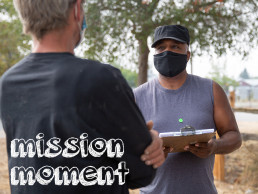As COTS’ CEO, each month I take a moment to consider what I want our community to know about our organization and our progress in serving Sonoma County’s homeless. I look forward to sharing these thoughts with you in this Virtual Cup of Coffee – my monthly communique about the business and mission moments of COTS (Committee On The Shelterless).
Happy New Year,
Chuck

Annual Point in Time (PIT) Count
We recently received the results of the Annual Point in Time Count conducted in February 2020. Because of COVID, it took some six months longer to get the results. Teams were dispersed throughout Sonoma County to count individuals and families sleeping on the streets, in cars, abandoned properties, under bridges, and other places not meant for human habitation (considered unsheltered). We also counted people living in shelters (considered sheltered).
Why do this?
The PIT is the only source of national data on sheltered and unsheltered homeless and is required by the U.S. Department of Housing and Urban Development (HUD). This data helps the federal government better understand homelessness and also helps local communities in their strategic planning, capacity building, and advocacy campaigns to prevent and end homelessness.
All the data are collected by a consulting firm who then runs it through numerous calculations and algorithms to produce the results. If you love statistics, then you’ll love all the data that is produced. The report is some 80 pages and is an excellent source of all things homelessness in the County.
Show me the numbers…
Here are some 2020 results that may answer some questions:
- 2,745 – Total sheltered and unsheltered experiencing homelessness in Sonoma County
- 7% – Reduction in homelessness from 2019
- 597 – Total sheltered and unsheltered experiencing homelessness in South County, which is Cotati, Petaluma, Rohnert Park
- 33% – Increase in homelessness in South County from 2019. Rohnert Park accounted for the biggest increase – from 129 in 2019 to 248 in 2020, a 92% increase
- 296 – Total sheltered and unsheltered experiencing homelessness in Petaluma
- 12% – Increase in homelessness in Petaluma from 2019
Some other important 2020 results…
- 73% of homeless were men and 27% were women
- 64% were White; 19% Multi-Race; 9% American Indian or Alaskan Native, 6% Black or African American
- 31% were homeless for the first time
- 19% were age 50 or older
- 60% were homeless for 1 year or more
- 29% had their dwelling burned, destroyed, or had smoke damage due to the fires
- 22% were homeless due to loss of a job
- 16% were homeless due to alcohol or drug use
- 15% were homeless due to an argument with family or friend
- 70% indicated that they could not afford the rent to get housing
- 36% indicated drug or alcohol abuse
- 40% indicated psychiatric or emotional conditions
- 39% had a history of domestic violence
- 139 – the number of Veterans that were homeless
So, what does all this mean? Couple of things.
More shelters do not end homelessness. More housing does. Because of the lack of affordable housing and supply/demand issues, homeless service providers must have seasoned real estate professionals that work with landlords and developers to get more housing. We also need to try new approaches, like a tiny homes village that could house people at lower costs and with dignity. Or purchase a fourplex to house families and children instead of putting them in a shelter. Children suffer from embarrassment when a school bus picks them up at a homeless shelter. We could also consider leasing homes throughout the community, each specializing in the different homeless sub-populations – those working on sobriety, adults wanting to be together, homes for women, seniors, Veterans, or LGBTQIA+/gender non-conforming.
Intense Wrap-Around Services. One of the tenets of Housing First is to get people off the streets and then provide them with services to help them stabilize and address their issues that made them homeless. One can’t work on their challenges if they don’t have the security and safety of a home.
Collaboration. Homelessness is complicated and if we are to make more progress, we must do it together – with health care providers, mental health specialists, law enforcement, City and County officials, the faith community, other homeless providers, volunteers, and the donors who make important contributions to continue this vital work.
Because of COVID, we will only count the sheltered in 2021. We are certain that there will be more unsheltered because of the impact of the pandemic on our community. Yes, we have lots of work ahead of us. But we also envision a community where everyone has a place to call home.

Until next month,

Chuck Fernandez